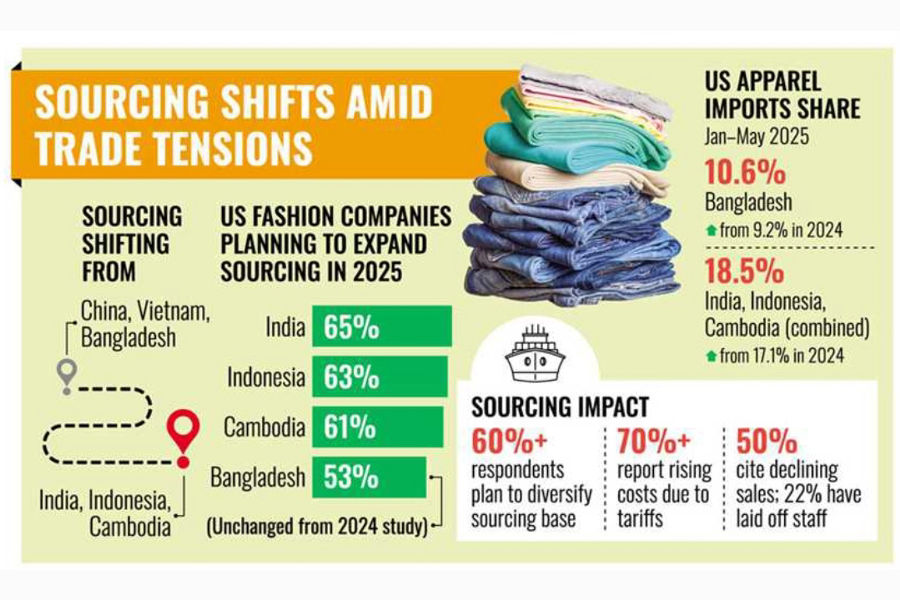Tariff tensions shake up sourcing map
BD may face setback as US fashion brands shift focus to emerging rivals

Published :
Updated :

Rising tariff and trade tensions under the Trump administration are driving US fashion companies to look beyond their traditional apparel-sourcing bases-China, Vietnam, and Bangladesh.
Instead, countries like Indonesia, India, and Cambodia are emerging as the new front-runners in the shifting global supply chain, according to the 2025 Fashion Industry Benchmarking Study, released on Tuesday.
More than 60 per cent of surveyed US fashion executives plan to expand sourcing from these three emerging players over the next two years.
While Bangladesh remains a key low-cost supplier, especially for basic apparel categories, concerns about future trade restrictions and heavy reliance on Chinese textiles are holding back more substantial expansion, the study revealed.
US fashion companies that are directly affected by the Trump administration's escalating tariffs are considering Indonesia, India, and Cambodia as the most promising sourcing destinations, overtaking three traditional suppliers, including Bangladesh, according to the latest industry study.
"Respondents generally believe that these countries have already developed considerable apparel production capacity and can serve as immediate alternatives to the traditional top three suppliers -- China, Vietnam and Bangladesh," the study noted.
Regarding Bangladesh, around 53 per cent of respondents expressed an interest in expanding apparel sourcing from the country over the next two years, similar to 48 per cent in the 2024 survey.
However, there are mounting concerns that apparel imports from Bangladesh may face future US trade restrictions, driven by its rising trade surplus with the US and a perceived overdependence on Chinese raw textile inputs.
"These concerns appear to hold US fashion companies back from substantially increasing their apparel sourcing from Bangladesh in the context of sourcing diversification and reducing 'China exposure'," the report stated.
On July 7, US President Donald Trump officially notified Bangladesh of a flat 35-percent tariff to be imposed on all Bangladeshi exports.
Previously, on April 2, the US had announced reciprocal tariffs on several countries, including a 37-percent duty on Bangladeshi goods.
However, this was temporarily replaced by a 10-percent flat rate, which was extended until August 1 after expiring on July 9.
Despite the challenges, Bangladesh's share of US apparel imports rose to approximately 10.6 per cent in the first five months of 2025, up from 9.2 per cent during the same period in 2024.
In contrast, Indonesia, India, and Cambodia together accounted for 18.5 per cent of US apparel imports in the same period, compared to 17.1 per cent a year earlier.
"These countries also present relatively lower sourcing risks compared to China, making them attractive options for fashion companies aiming to mitigate supply chain vulnerabilities," the study added.
The report also noted that US fashion firms still view Bangladesh as a reliable destination for low-cost, high-volume basics, such as knit cotton shirts and trousers. However, concerns remain around social and environmental compliance risks.
The twelfth edition of the annual survey was jointly conducted by the United States Fashion Industry Association (USFIA) and the University of Delaware.
It covered executives from 25 leading US fashion brands, retailers, importers, and wholesalers, including several of the largest brands in the country, between April and June 2025.
Tariffs are already affecting operations, the report warned. Over two-thirds of companies surveyed have delayed or cancelled orders.
Suppliers, forced to absorb part of the tariff costs, are now at risk of financial distress or closure.
More than 70 per cent of respondents said higher tariffs have increased sourcing costs, reduced profit margins, and driven up consumer prices. Nearly 50 per cent reported declining sales, and 22 per cent confirmed layoffs in their workforce.
Despite the upheaval, US companies continue to pursue supply chain diversification. In 2025, apparel was sourced from 46 countries, with 60 per cent of respondents indicating plans to expand sourcing, excluding China.
Over 60 per cent of respondents allocated more than 30 per cent of their apparel sourcing to Vietnam and Bangladesh combined this year, up from just one-third in 2024.
At the same time, it has become increasingly common for companies to allocate more than 10 per cent of their sourcing to India, Cambodia, and Indonesia, signalling not only improved production capacity but also their growing importance as long-term supply partners in the global apparel value chain.
When asked, Bangladesh Garment Manufacturers and Exporters Association (BGMEA) President Mahmud Hasan Khan said each big buyer has their own country risk analysis and business cannot be shifted from Bangladesh overnight.
The competition from Indonesia, India and Cambodia could be a big challenge for Bangladesh if the tariff gaps go higher for Bangladesh than others, he said.
He added that existing internal issues, including high cost of doing business and poor infrastructural bottlenecks, are not addressed timely.
Munni_fe@yahoo.com


 For all latest news, follow The Financial Express Google News channel.
For all latest news, follow The Financial Express Google News channel.